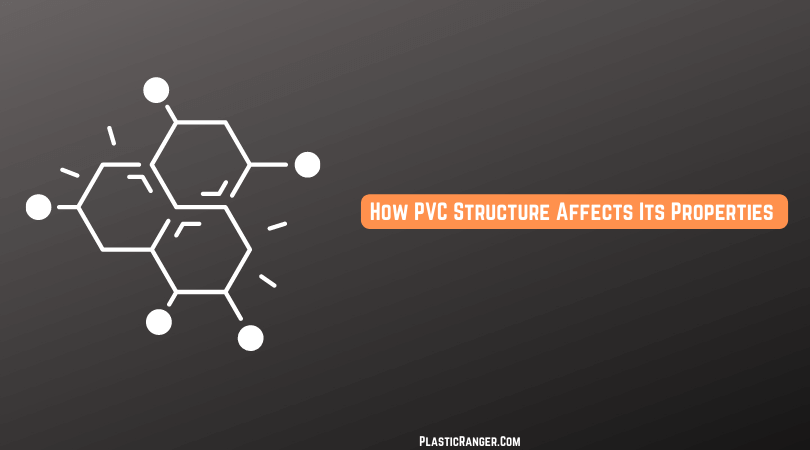Structure of PVC
The structure of PVC involves a lengthy chain of vinyl chloride molecules, which contain chlorine, hydrogen, and carbon atoms, depicted by the chemical formula C2H3Cl.
PVC is a thermoplastic polymer extensively utilized in the construction industry to produce door and window profiles, drinking and wastewater pipes, wire and cable insulation, medical devices, and other products.
It is the third most abundant plastic material globally, following polyethylene and polypropylene.
In this article, I will give a detailed outlook on PVC structure and how it affects the polymer’s general properties and other aspects.
Composition and Chemical Structure of PVC
PVC is a polymer composed of multiple repeating units of vinyl chloride monomers. Vinyl chloride is a colorless gas known to be highly toxic and flammable.
Individual vinyl chloride monomers are combined during the polymerization process to create long chains, ultimately forming PVC.
The chemical structure of PVC can be represented as (C2H3Cl)n, where n is the number of repeating units in the polymer chain.
The carbon-carbon double bond in the vinyl chloride monomer is replaced by a single bond when the monomer joins with another monomer to form the polymer chain.
This single bond results in the PVC chain being saturated, meaning that all of the carbon atoms in the chain are bonded to two other atoms, either hydrogen or chlorine.
The molecular weight and degree of polymerization of PVC are subject to variation depending on the manufacturing process and the intended application of the material.
Generally speaking, the molecular weight of PVC can fall within a range of 50,000 to 150,000 g/mol, while the degree of polymerization can span from 700 to 2000.
The chemical composition of PVC can differ based on adding specific stabilizers and additives during manufacturing.
To enhance the flexibility and workability of PVC, it is often blended with other materials, such as plasticizers.
Phthalates, adipates, and trimellates are among PVC’s most commonly utilized plasticizers.
How the Structure of PVC Affects its Properties

PVC’s physical, mechanical, thermal, and melting properties are significantly influenced by its structure.
The following are some ways in which PVC’s structure impacts these properties:
Melting Point
The degree of polymerization and molecular weight of PVC significantly impact its melting point, with higher degrees of polymerization and molecular weights typically resulting in higher melting points.
The melting point of PVC is also affected by its structure, with PVC that exhibits a higher degree of crystallinity generally having a higher melting point.
Physical Properties
PVC’s physical properties, including its density, transparency, and hardness, are determined by its chemical composition, degree of crystallinity, and molecular weight.
PVC typically has a low density and is transparent when not pigmented. To modify PVC’s hardness, the degree of crystallinity can be adjusted by adding plasticizers or other additives.
Mechanical Properties
The mechanical properties of PVC, such as strength, elasticity, and toughness, are influenced by the structure of the polymer chain.
PVC with a high degree of polymerization and molecular weight typically exhibits greater strength and rigidity.
In contrast, PVC with a lower degree of polymerization and molecular weight tends to be more flexible and elastic.
Thermal Properties
PVC’s thermal properties, including its thermal stability, thermal conductivity, and heat resistance, are affected by its chemical structure and any added additives.
Generally, PVC is not very thermally stable, but adding stabilizers can enhance its heat resistance. Additionally, PVC’s thermal conductivity is relatively low, making it sound like an insulator.
How PVC Structure Affects its Applications
PVC is a chain of repeating units of vinyl chloride monomers, creating a versatile and robust polymer.
This chain-like structure, combined with chlorine-carbon solid bonds, makes PVC durable and resistant to environmental degradation.
These properties ushered PVC into applications where resilience is indispensable – from construction materials like pipes and window frames to healthcare products like blood bags and tubing. Yet, the molecular tale of PVC does not end here.
It is a thermoplastic, allowing it to be softened and remolded with heat.
This intrinsic property, a direct result of its polymer structure, enables PVC to be transformed into products of various shapes and sizes, thus amplifying its application spectrum.
But perhaps the most compelling chapter in PVC’s structural story is its ability to accept additives, again due to its versatile structure.
Plasticizers make it flexible for applications like electrical cable insulation, while flame retardants improve safety.
From a structural viewpoint, PVC is not just a polymer; it’s a canvas for innovation, shaping the world, one application at a time.
Summary
PVC structure consists of lengthy chains of carbon atoms joined by alternating single and double bonds, along with chlorine atoms bound to the carbon backbone.
This distinctive structure gives PVC advantageous weather, chemical resistance, and durability advantages.
Nevertheless, the environmental consequences of PVC production and disposal are worrisome, driving the search for greener alternatives.
Comprehending PVC’s chemical structure for practical applications and effectively managing its environmental effects is essential.
Thanks for reading. Have a wonderful day.
Quick Navigation

